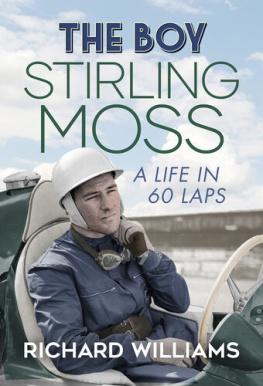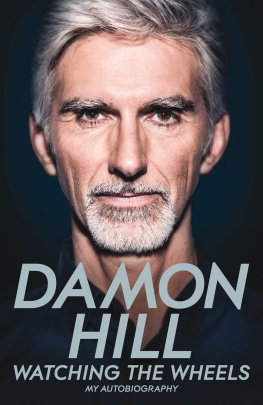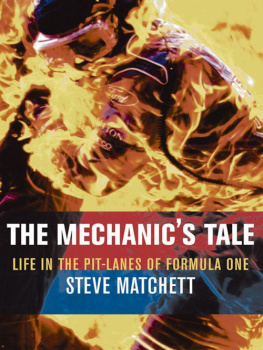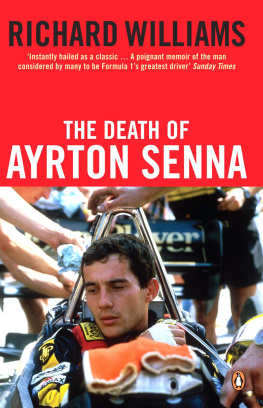AN ORION EBOOK
First published in Great Britain in 1995 by Weidenfeld & Nicolson
This ebook first published in 2011 by Orion Books
Copyright Steve Matchett 1995
The right of Steve Matchett to be identified as the author of this work has been asserted by him in accordance with the Copyright, Designs and Patents Act 1988.
All rights reserved. No part of this publication may be reproduced, stored in a retrieval system or transmitted in any form or by any means, without the prior permission in writing of the publisher, nor to be otherwise circulated in any form of binding or cover other than that in which it is published without a similar condition, including this condition, being imposed on the subsequent purchaser.
A CIP catalogue record for this book is available from the British Library.
ISBN: 978 1 4091 3705 4
The Orion Publishing Group Ltd
Orion House
5 Upper Saint Martins Lane
London WC2H 9EA
An Hachette UK Company
www.orionbooks.co.uk
Written for my mum
and dedicated to the memory
of Ayrton and Roland
Try not to feel too sad. Remember him for everything
he achieved in life. Ayrton was Formula One.
Hell never be forgotten.
Sheila Matchett, Monday 2 May 1994
When Steve asked me to write this foreword, it was an invitation which I quickly accepted.
In the past, much has been written about the lives of Grand Prix drivers, but surprisingly very little about their mechanics. Steves account of the 1994 season, as we fought for the Drivers and Constructors World Championships, in what turned out to be one of the most turbulent years in Formula Ones history, gives a tremendous insight into life within our sport.
The dedication and effort required of the mechanics to ensure that the cars are prepared and maintained, and made ready to race, coupled with their ability to work under pressure, and to seemingly impossible deadlines, is simply staggering. To have written such an entertaining and informative book in what little spare time a mechanic has available is a remarkable achievement, and I am only too pleased to be able to give him my full support.
Michael Schumacher

The management of Benetton Formula and the Benetton family have been very supportive during the writing of this book, but I feel I must point out that the views and opinions I express are exactly that: my opinions. Because of the controversy surrounding the 94 season, some people might be inclined to think that LIFE IN THE FAST LANE is an official release or a commissioned work by Benetton Formula. This is certainly not so. The work is entirely the result of my own independent efforts.
I hope you enjoy it.
I would just like to say thank you for the help and encouragement I have received throughout the year to:
Luciano Benetton, Alessandro Benetton, and Flavio Briatore, for lending me their full support; Joan Villadelprat, and Mick Ainsley-Cowlishaw for their encouragement, and allowing me the time to work on the book; Michael Schumacher, for writing the foreword in between Suzuka and Adelaide (at a time when he obviously had an awful lot of other things to think about); Jos Verstappen, for keeping me busy all year; Patrick Spinelli, John Postlethwaite, and Rod Vickery for all their help, time and advice; Kenny Handkammer, for the loan of his printer, and constant interest in how our book was progressing; Bat for patiently explaining and re-explaining the basics of how to drive a Compaq 486 lap-top; Diane Ball, for being such a wonderful sister; Sarah Rouche, for her month-by-month proof-reading (her wonderful appreciation and correct use of the English language, combined with her complete lack of interest in motor-racing has proved invaluable); Steven Tee, for his superb photographs; Michael Dover, for his enthusiasm and faith in the project; and finally, the Benetton Race Team for being themselves.
Thank you all very much indeed.
Steve Matchett
Chipping Norton
Oxfordshire
January 1995
Last September I decided to buy the cottage which I had previously been renting, thereby transforming overnight my social status within our small community. Before then I had been just another here today, gone tomorrow temporary tenant, only using the Cotswolds for as long as it suited me. Now I had become a fully-fledged permanent resident, perfectly within my rights to complain about the day-trippers and tourists stealing all the parking spaces.
I spent most of December 93 encamped in the bathroom, tiling the walls and re-panelling the bath with old, pine floor boards I had come across in an antique shop in Faringdon, a village about twenty miles away from my new home at Chipping Norton. Admittedly, this was tedious DIY work, but it had to be done for I knew that if I didnt get on and finish it during the Christmas holidays, it would be another twelve months before I would have the chance to complete it. Once the holidays were over I would be either working, or away from home for almost 90 per cent of the year.
The cottage had originally been a small stable block at one end of a large barn. It was apparently one of the first barn conversions in the country, being transformed into cottages well over three hundred years ago. What had originally been built to accommodate two or three horses and their tackle now provided a compact, but comfortable dwelling for a coffee machine, two people and three small unenthusiastic vines, which I had planted at the rear.
The property has many attractive features: exposed beams, Cotswold stone walls, an inglenook fireplace, a row of grave-yard head-stones leaning against the garden wall. Even a body buried in the back yard. These centuries-old remains were discovered (and later reburied) by the builders during the course of restoration work. Everything in fact to make an estate agent rub his hands together and remember the good old days of the low effort/ high profit 1980s.
However, amongst the key features which sold the place to me, was the fact that I was already living there and thus didnt have to bother with the time-consuming trouble of physically looking for a house to buy, and endure all the accompanying frustration and irritation of actually moving. That, and the fact that the cottage is only a ten minute drive to work, made it the perfect purchase.
I work for a company which is based just between the tiny Oxfordshire villages of Middle Barton and Gagingwell, two quiet and sleepy hamlets that have remained unchanged for hundreds of years. The majority of their residents are farm animals and the farmers who tend them.
It is sometimes difficult to believe as you drive through this idyllic English countryside that right next door to the grazing sheep and snoozing pigs is the most advanced production facility for sophisticated racing vehicles anywhere in the world.
For this is where the new headquarters for Benetton Formula are based, and it is for Benetton that I work, as a mechanic on the companys Grand Prix racing team.
By a clever piece of architectural design, the whole factory has been built in a hollow. The roof is set at ground level, and from a short distance the whole factory appears almost invisible. The only signs that we are there are the small security office, the Benetton Formula One emblem carved out of stone and set into a traditional dry stone wall, and three flagpoles. One flying the Italian flag, one the Union Jack, and a third the new flag of the EEC.











